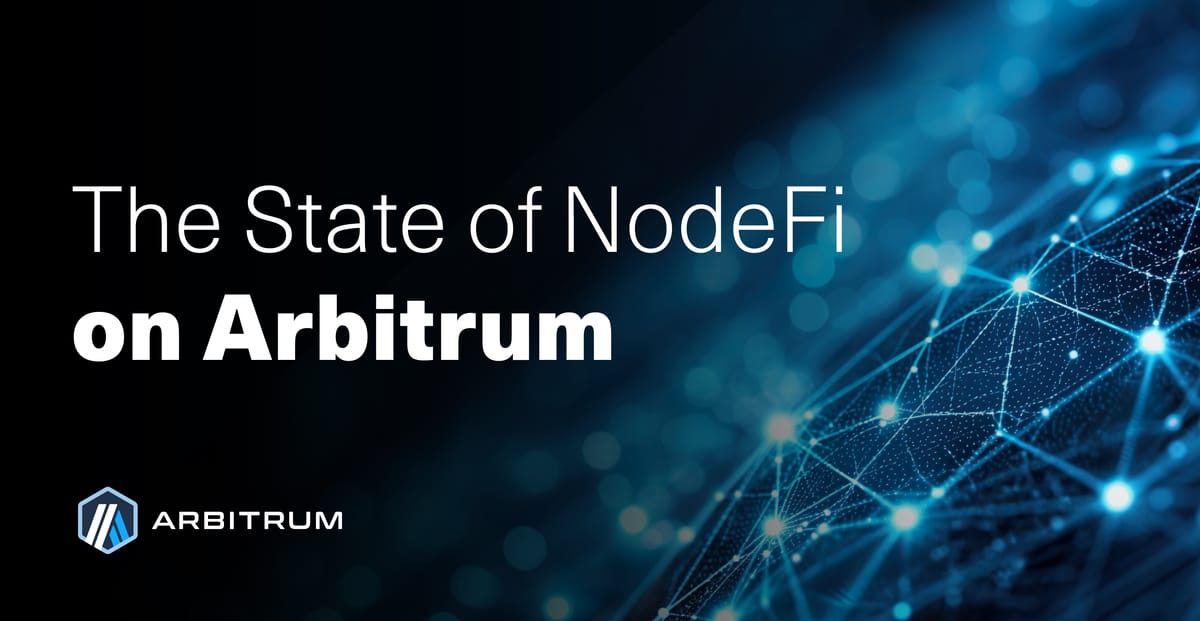The State of NodeFi on Arbitrum

Node Financing (NodeFi) is rapidly gaining interest in the decentralized finance (DeFi) space as a transformative force in the blockchain economy. It enables node operators to unlock liquidity from their Node Licenses (ERC-721s), bringing traditionally hard-to-trade assets into DeFi and introducing innovative financing options that maximize the full financial potential of nodes.
In simple terms, NodeFi is a financial primitive designed to help node owners optimize their assets by bringing new financial innovations and incentives to nodes. This momentum is already evident—NodeFi has surpassed $200M in TVL through this new initiative, highlighting the growing demand for liquidity solutions in the node economy.
One way that NodeFi achieves this is through yield tokenization, turning node earnings into tradeable tokens. Another innovation in NodeFi is collateralization, where node operators can borrow assets using their nodes as collateral, and liquidity provision, where the sale, purchase, or trade of tokenized node yields is simplified. It is similar to Pendle, but instead of using points to reward users for participating in its ecosystem, NodeFi uses the node’s emissions over time.
Introducing these different financial tools to nodes allows its owners to transform static infrastructure into economic assets while simultaneously driving the growth and scalability of decentralized networks.
Origins of NodeFi on Arbitrum
A node is a device or software instance that powers a blockchain network. Depending on the type of blockchain and its specific configuration, nodes perform various roles. For example, a full node on Arbitrum One would be responsible for storing blockchain data, validating and propagating transactions and blocks, and ensuring the network’s integrity and security.
NodeFi originated from the rise of node sales and licensing. The team at MetaStreet observed that node sales required substantial upfront capital with long payback periods, resulting in illiquid but cash-flow generating assets. While these fundraises gained traction, attracting multi-billion-dollar players like CARV, Aethir, and XAI on Arbitrum, the momentum eventually slowed. Users found themselves locked into long-term commitments, with limited liquidity to reinvest in other node fundraises, constraining broader ecosystem growth.
Realizing this could be capitalized, MetaStreet collaborated with Xai to create a proof of concept that made nodes indirectly tradeable using derivatives to unlock short-term cash flows. This process split nodes into the yield generated and the principal ownership, similar to separating a property's rental income from its deed.
NodeFi aims to unlock the value of productive, illiquid assets that traditional financial systems overlook, such as Bitcoin miners and crypto market makers, without relying on outdated concepts like tokenizing real estate. This innovative direction highlights the broader applicability of NodeFi's primitives. Node licenses may be the first use case enabled by NodeFi, but the framework extends far beyond. It unlocks new possibilities for other productive yet illiquid assets, such as core crypto infrastructure, including DePIN, GPUs, tokenized validators, and AI hardware.
The current state of NodeFi on Arbitrum: Liquidity Unlock
Following MetaStreet and Xai’s footsteps, other projects, including Aethir and CARV, also saw the benefits of NodeFi. These projects benefit from being on Arbitrum due to its lower gas fees and faster transactions compared with other Ethereum layer 2s. This makes it more economical to deploy nodes and participate in financial activities that would be otherwise impossible given the calldata costs related with complex ERC-721s transactions. Today, node owners are able to access a handful of use cases on Arbitrum networks. This includes:
1. Unlocking the Value of Illiquid Node Assets
NodeFi solutions on Arbitrum allow node owners to unlock the value of illiquid blockchain nodes, being able to draw from its future cash flows with instant liquidity. By tokenizing the yield or collateralizing nodes, node owners can access liquidity without selling the underlying economic ownership.
2. Creation of new Node Derivatives Markets
As mentioned previously, a node’s value can be split into distinct derivatives, which include:
- Yield Tokens: Represent the income generated by the node over time; and
- Principal Tokens: Represent ownership of the node itself.
This separation creates new financial products that can be traded or used in DeFi.
3. Speculate or optimize Node Rewards
By integrating with DeFi primitives, node owners can maximize the efficiency of their node-generated rewards by:
- Staking node-related assets in liquidity pools;
- Using yield tokens as collateral for loans for other DeFi operations (swaps, LP, etc); and/or
- Swapping & speculating on the discounted value of yield tokens.
Preparing for Future Growth
NodeFi represents a shift in DeFi's focus from purely liquid assets to capital markets for productive, illiquid assets. Through the innovative use of derivatives to approximate the value of illiquid assets, teams such as MetaStreet and Xai are laying the foundation for future onchain capital markets.
According to David Choi, founder of Permian Labs, the team behind MetaStreet, the vision for NodeFi is expanding beyond digital nodes into decentralized physical infrastructure networks (DePIN). This evolution integrates hardware-backed assets, such critical AI and blockchain infrastructure assets, into the broader NodeFi ecosystem. While node licenses remain foundational, the same financial principles can unlock liquidity for other illiquid but cash-flow generating assets.
With the U.S. government recently committing up to $500 billion toward AI infrastructure and Bitcoin mining firms carrying over $10 billion in debt, the total addressable market for decentralized infrastructure finance has potential. NodeFi is positioning itself as a "decentralized Stargate," bridging capital markets with the next generation of onchain infrastructure.
As NodeFi matures, its potential to redefine how blockchain infrastructure is monetized and optimized will likely expand, benefiting both individual operators and the broader decentralized economy.
